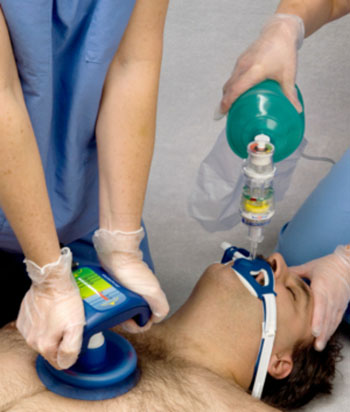Combination CPR System Increases Cardiac Blood Flow
By HospiMedica International staff writers
Posted on 07 Apr 2015
A synergetic cardiopulmonary resuscitation (CPR) system uses two separate devices to improve long-term survival rates by 50%.Posted on 07 Apr 2015
The ResQCPR System is based on intrathoracic pressure regulation (IPR), an innovative technology that uses the body’s own mechanisms to enhance circulation, without the use of pharmaceutical or other agents. The system comprises of two devices, the ResQPOD impedance threshold device and the ResQPUMP active compression-decompression CPR Device, which work together in synergy to improve perfusion. As the chest wall recoils, the vacuum in the thorax is enhanced, more than doubling blood flow during CPR. The mechanism increases cardiac output, blood pressure, and survival rates.

Image: The ResQPump and the ResQPOD during CPR (Photo courtesy of ZOLL).
The ResQPOD inspiratory impedance threshold device is based on a valve inside the mask that improves venous return to the heart. The mask is placed over the mouth, helping to properly move air in and out of the lungs and increase blood flow to the heart and the brain, thus effectively raising the chances of survival while reducing the possibility of neurological damage. The ResQCPR System is a product of ZOLL Medical Corporation (ZOLL; Chelmsford, MA, USA), developed by Advanced Circulatory Systems (ACS; Roseville, MN, USA).
“The ResQCPR System is a huge advance in the treatment of cardiac arrest and we look forward to working with clinicians and rescuers around the country to implement this new system of care to increase the likelihood of survival from cardiac arrest and the potential to return patients to a full life after critical medical emergencies,” said Mike Black, president of ACS, now part of ZOLL. “This technology demonstrates ZOLL’s commitment to offering the most comprehensive portfolio of products for acute events.”
An inspiratory impedance threshold valve enhances the return of blood to the thorax during the decompression phase of CPR, resulting in a greater negative intrathoracic pressure during chest wall decompression. This leads to improved vital organ perfusion during both standard and active compression-decompression (ACD) CPR. It works by harnessing the kinetic energy of the outward movement of the chest wall during CPR. When used in conjunction with ACD CPR, the addition of the impedance valve results in sustained systolic blood pressures greater than 100 mmHg and diastolic pressures greater than 55 mmHg.
Related Links:
ZOLL Medical Corporation
Advanced Circulatory Systems














